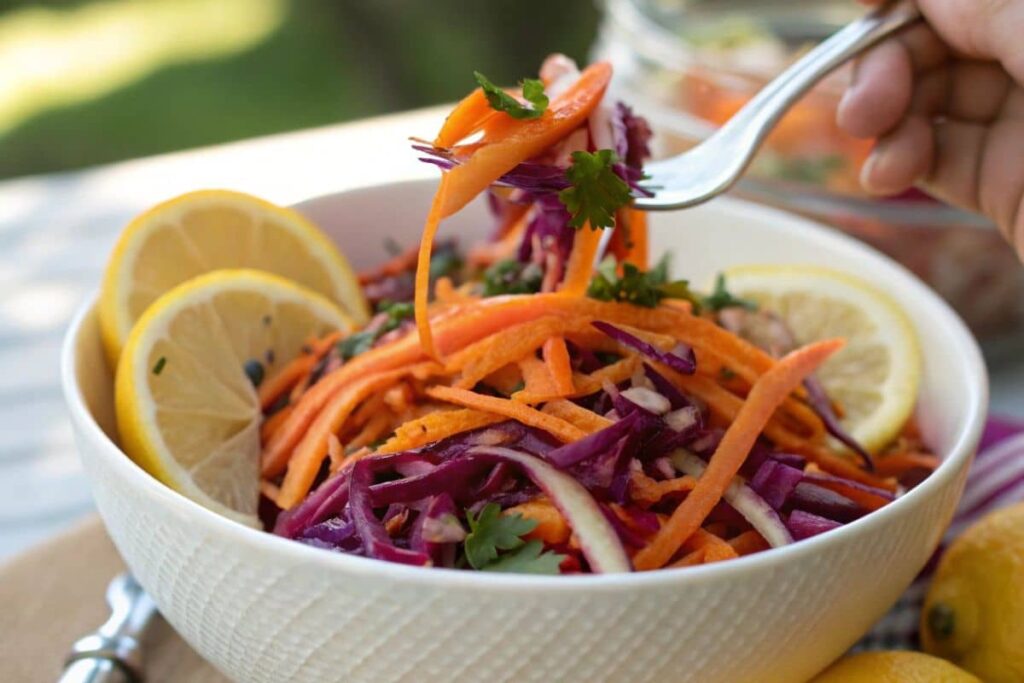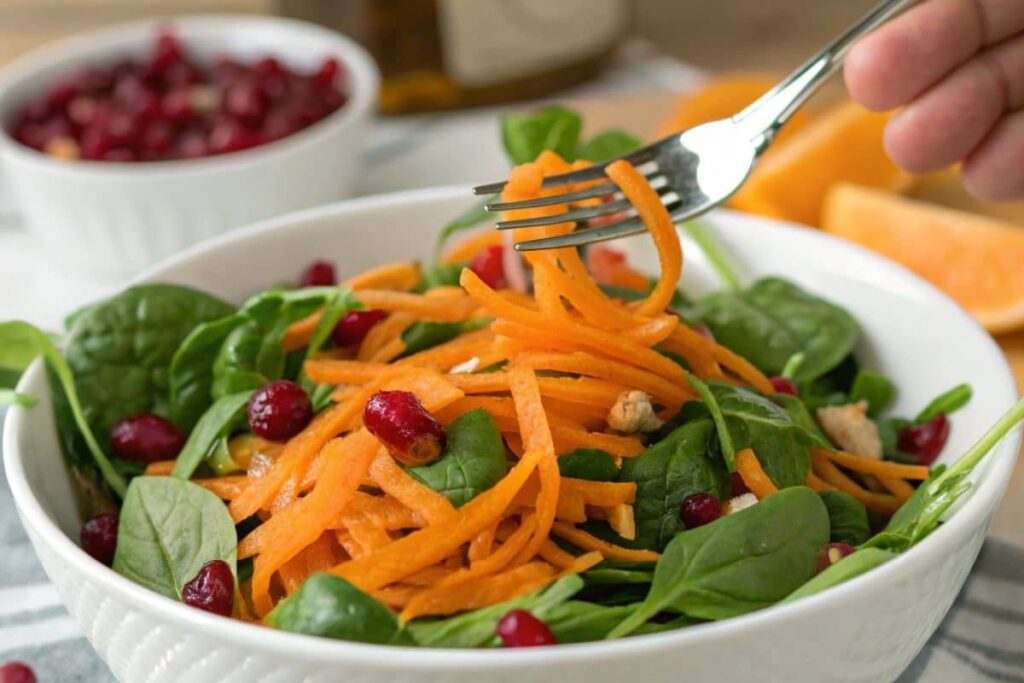When we think of sweet potatoes, our minds often jump to warm, comforting dishes like baked sweet potatoes or mashed casseroles. But have you ever wondered, can you eat raw sweet potato? 🌱 This question might surprise you, but the answer is more fascinating than you’d expect. Let’s dive into the benefits, risks, and creative ways to enjoy raw sweet potatoes!
Table of Contents

What Makes Sweet Potatoes Special?
Sweet potatoes aren’t just your average vegetable—they’re a powerhouse of nutrition and versatility. They’re rich in flavor, bright in color, and packed with nutrients that are amazing for your body.
Nutritional Benefits of Sweet Potatoes
Here’s why sweet potatoes are considered a superfood:
| Nutrient | Amount per 100g (Raw) | Benefits |
|---|---|---|
| Calories | 86 | Provides energy without excess fat. |
| Carbohydrates | 20.1g | Keeps you energized throughout the day. |
| Dietary Fiber | 3g | Supports healthy digestion. |
| Vitamin A | 283% of RDI | Essential for good vision and skin health. |
| Vitamin C | 4.6mg | Boosts your immune system. |
| Potassium | 337mg | Helps maintain healthy blood pressure. |
Difference Between Sweet Potatoes and Regular Potatoes
These two often get lumped together, but they’re not the same. The sweeter variety has a softer texture when cooked, while standard potatoes are starchier and milder in taste. Interestingly, they belong to different plant families. What sets the orange-hued option apart is its higher antioxidant levels and rich vitamin A content. Think of it as the vibrant, fun cousin of the more neutral-tasting potato.
Can You Eat Them Raw?
Here’s where things get interesting. Yes, they can be eaten uncooked, but it’s not as simple as grabbing one and biting into it like an apple. In their raw state, they’re crunchy, mildly sweet, and refreshing. However, there are a few things to consider before diving in.
Health Benefits of Eating Raw Sweet Potato
Eating raw sweet potatoes offers a unique set of benefits.
- Rich in Enzymes: Raw sweet potatoes contain natural enzymes that aid digestion. When eaten raw, these enzymes are intact, unlike when the potato is cooked.
- Crunchy and Satisfying: Raw sweet potatoes have a satisfying crunch, making them a great alternative to chips or crackers for snacks.
- Retains Maximum Nutrients: Cooking sweet potatoes can sometimes reduce their vitamin content, especially vitamin C. Eating them raw ensures you get the full nutritional package.
“Eating raw sweet potatoes is like biting into a refreshing, slightly sweet carrot with a unique twist.”
Potential Risks of Eating Raw Sweet Potato
Okay, let’s not sugarcoat it—there are some risks, too:
- Harder to Digest: Raw sweet potatoes contain a compound called trypsin inhibitors, which can interfere with your body’s ability to digest protein.
- Possible Bloating: Eating them raw may cause mild digestive discomfort for some people, especially if consumed in large quantities.
- Raw Texture Isn’t for Everyone: While some people love the crunch, others might find raw sweet potatoes too tough or fibrous to enjoy.
That being said, moderation is key. If you’re curious about eating raw sweet potatoes, start small and see how your body reacts.
Raw vs Cooked Sweet Potatoes: Which Is Better?
Let’s settle the debate! While raw sweet potatoes have their perks, cooking them does have its own set of advantages.
| Aspect | Raw Sweet Potatoes | Cooked Sweet Potatoes |
|---|---|---|
| Taste | Crunchy and mildly sweet | Soft, sweet, and caramelized |
| Nutrient Content | Higher in vitamin C and enzymes | Better beta-carotene absorption |
| Digestibility | Harder to digest | Easier on the stomach |
| Versatility | Best in salads, smoothies, or raw snacks | Great for baking, mashing, or frying |
So, which one should you choose? It depends on your preference and what you’re looking for. For a quick and healthy crunch, raw is the way to go. But if you’re craving that soft, cozy flavor, cooked sweet potatoes win the day.
Common Questions About Eating Raw Sweet Potatoes
When it comes to eating them uncooked, people often have a lot of questions. Let’s tackle a few of the most common ones.
Does It Taste Good?
Surprisingly, yes! Uncooked sweet potatoes have a mildly sweet flavor with a crunchy texture, similar to a carrot. If you enjoy raw veggies like carrots or bell peppers, chances are you’ll love this fresh and crisp alternative.
Can They Cause Digestive Issues?
For some, eating them uncooked may lead to mild bloating or gas, mainly due to their high fiber content. However, this isn’t a problem for most people, especially when consumed in moderation.
Are There Toxins to Worry About?
Unlike regular potatoes, which contain solanine, sweet potatoes don’t have harmful toxins. However, they do contain natural compounds that might be harder to digest, as mentioned earlier. Don’t worry, though—it’s not a major health concern unless you overconsume them.
How to Safely Eat Raw Sweet Potatoes
If you’re curious about adding this root vegetable to your diet in its uncooked form, it’s essential to know how to prepare it safely and enjoyably. At first glance, it might seem intimidating, but with the right approach, it can quickly become your new favorite snack. Let’s break it down step by step for the best experience.
Preparing Sweet Potatoes for Raw Consumption
Before diving into your raw sweet potato adventure, proper preparation is key:
- Wash Thoroughly: Sweet potatoes grow underground, so they’re often covered in dirt. Use a vegetable brush and scrub them under running water to remove all dirt and bacteria.
- Peel or Keep the Skin: The skin is perfectly safe to eat and packed with fiber, but if you prefer a smoother texture, go ahead and peel it off.
- Slice Thinly: Raw sweet potatoes can be tough to bite into, so slicing them thinly makes them much easier (and more enjoyable!) to eat.
Best Ways to Slice and Store Raw Sweet Potatoes
- Thin Slices for Snacking: Use a mandoline slicer for perfectly thin, chip-like slices. These are great for dipping into hummus or guacamole.
- Julienne for Salads: Julienne strips (thin matchstick cuts) are perfect for tossing into salads or bowls.
- Store Properly: Once sliced, raw sweet potatoes can dry out quickly. Store them in an airtight container in the fridge and submerge them in water to keep them crisp.
“Think of raw sweet potatoes as a blank canvas—you can turn them into snacks, salads, or even smoothies with a little creativity!”
Popular Raw Sweet Potato Dishes You’ll Love
Ready to get creative? Here are some delicious ways to enjoy raw sweet potatoes:
- Raw Sweet Potato Salad: Combine julienned sweet potato strips with baby spinach, dried cranberries, and a tangy lemon vinaigrette.
- Sweet Potato Smoothie: Blend raw sweet potato chunks with almond milk, banana, and a dash of cinnamon for a nutrient-packed breakfast.
- Raw Sweet Potato Chips: Season thin slices with paprika and sea salt, then enjoy them fresh or dehydrate them for an extra crunch.
Who Should Avoid Eating Raw Sweet Potatoes?
While generally safe, raw sweet potatoes may not be suitable for everyone. Here’s a quick guide to who might want to skip them:
Individuals with Allergies or Sensitivities
Some people may experience mild allergic reactions, such as itching or swelling. If this happens, it’s best to avoid eating them raw and consult a doctor.
People with Digestive Disorders
Raw sweet potatoes are high in fiber, which is fantastic for digestion—but not for those with conditions like IBS (Irritable Bowel Syndrome). The fibrous texture might be irritating for sensitive stomachs.
The Science Behind Raw Sweet Potatoes
Ever wonder what happens inside your body when you eat this root vegetable in its raw form? Let’s get a little geeky and dive into the science.
How Digestive Enzymes React
Raw sweet potatoes contain amylase, a natural enzyme that helps break down starches into sugars. This explains their mild sweetness even when uncooked. However, their high fiber content might slow digestion for some, especially if you’re not used to eating raw vegetables.
Nutrient Retention: Raw vs. Cooked
One major perk of eating them uncooked is that they retain all water-soluble vitamins, like vitamin C. Cooking, especially boiling, can leach these nutrients out. However, cooking enhances beta-carotene bioavailability, making it easier for your body to absorb.
| Nutrient | Raw Sweet Potatoes | Cooked Sweet Potatoes |
|---|---|---|
| Vitamin A (Beta-Carotene) | Lower bioavailability | Higher bioavailability |
| Vitamin C | Retained | Partially lost during cooking |
| Fiber | Intact | Slightly softened |
Delicious Raw Sweet Potato Recipes to Try
Ready to get your hands dirty in the kitchen? Here are three easy raw sweet potato recipes that are not only delicious but also super simple to make.

Raw Sweet Potato Salad with Citrus Dressing
Ingredients:
- 1 medium raw sweet potato (julienned)
- 2 cups baby spinach
- 1/4 cup dried cranberries
- 2 tbsp olive oil
- 1 tbsp lemon juice
- 1 tsp honey
- A pinch of salt and pepper
Instructions:
- Combine the julienned sweet potato, spinach, and cranberries in a large bowl.
- Whisk together olive oil, lemon juice, honey, salt, and pepper in a small bowl.
- Pour the dressing over the salad, toss well, and enjoy immediately!
Sweet Potato Smoothie for a Healthy Boost
Ingredients:
- 1/2 cup raw sweet potato (peeled and cubed)
- 1 ripe banana
- 1 cup almond milk
- 1/4 tsp cinnamon
- 1 tsp maple syrup (optional)
Instructions:
- Add all ingredients to a blender and blend until smooth.
- Pour into a glass and enjoy a nutrient-packed breakfast or snack.
Raw Sweet Potato Chips: A Crunchy Snack
Ingredients:
- 1 medium sweet potato (thinly sliced)
- 1 tsp olive oil
- A pinch of paprika and sea salt
Instructions:
- Toss the sweet potato slices in olive oil, paprika, and sea salt.
- Enjoy them as-is, or use a dehydrator for an extra crunchy texture!
Spicy Raw Sweet Potato Slaw
Ingredients:
- 1 medium raw sweet potato (grated)
- 1 cup shredded red cabbage
- 1/2 cup grated carrots
- 2 green onions (sliced thinly)
- 2 tbsp apple cider vinegar
- 1 tbsp olive oil
- 1/2 tsp chili flakes (optional for spice)
- A pinch of salt and pepper
Instructions:
- In a large bowl, combine grated sweet potato, red cabbage, carrots, and green onions.
- In a small bowl, whisk together apple cider vinegar, olive oil, chili flakes, salt, and pepper.
- Pour the dressing over the slaw and toss until evenly coated.
- Serve immediately for a refreshing, crunchy dish with a spicy kick!
Raw Sweet Potato and Avocado Wraps
Ingredients:
- 1 large raw sweet potato (thinly sliced into ribbons using a peeler)
- 1 ripe avocado (sliced)
- 1 cup baby arugula or spinach
- 1 tbsp hummus or tahini
- 1/2 tsp lemon juice
- Whole grain tortilla or collard greens for wrapping
Instructions:
- Spread hummus or tahini over your tortilla or collard greens.
- Layer sweet potato ribbons, avocado slices, and baby arugula evenly.
- Sprinkle with lemon juice for extra zest.
- Roll tightly into a wrap, slice in half, and enjoy a nutrient-packed, handheld meal!
Addressing Common Misconceptions
When it comes to eating raw sweet potatoes, myths and misconceptions are everywhere. Let’s clear the air and separate fact from fiction so you can enjoy them with confidence.
Do Sweet Potatoes Need to Be Cooked to Be Healthy?
This is one of the biggest myths about sweet potatoes. While cooking sweet potatoes does enhance the absorption of beta-carotene, eating them raw offers unique benefits, like retaining more vitamin C and enzymes. So no, they don’t need to be cooked to be healthy—they’re nutrient-packed either way!
“Think of raw sweet potatoes as a different way to enjoy the same superfood, just like how some people prefer raw spinach over cooked.”
Are Raw Sweet Potatoes Hard to Digest for Everyone?
Not at all! While some people may find the fibrous texture challenging, most of us can enjoy raw sweet potatoes without any issues. The trick is to eat them in moderation and ensure they’re sliced thinly or grated to make them easier on your stomach.
Is Eating Raw Sweet Potatoes a New Trend?
Actually, no! In many cultures, raw sweet potatoes have been enjoyed for centuries. From raw salads in tropical countries to health-conscious smoothie bowls in the West, this isn’t just a modern foodie craze—it’s a rediscovery of an old, healthy habit.
The Verdict: Should You Eat Sweet Potatoes Raw?
So, should you give raw sweet potatoes a try? Let’s wrap it up with the pros and cons.
Weighing the Pros and Cons
| Pros | Cons |
|---|---|
| Retains vitamin C and enzymes | Can be harder to digest for some people |
| Crunchy, refreshing, and versatile | Tougher texture might not suit everyone |
| Great for quick, no-cook recipes | Less beta-carotene absorption than cooking |
| Perfect alternative to traditional raw veggies | Not ideal for individuals with allergies |
Final Recommendations for Sweet Potato Lovers
If you’re curious about raw sweet potatoes, go ahead and give them a shot! Start small, experiment with different recipes, and listen to your body. If you love them, they’ll become a crunchy, nutritious addition to your diet. And if you’re not a fan, no worries—you can always stick to the deliciously cooked versions we all adore.
“The bottom line: raw sweet potatoes are a surprisingly versatile, healthy option worth exploring. It’s like discovering a new side of an old friend!”
If you’re curious about other unique and versatile foods, you might enjoy learning about the Persian cucumber and its amazing benefits. And while we’re talking about sweet potatoes, did you know there’s a debate about whether sweet potato is a fruit or vegetable? Plus, their natural properties make them a standout anti-inflammatory food—read more about that in Is sweet potato anti-inflammatory?. For more culinary inspiration, don’t miss these creative purple sweet potato recipes to add vibrant color and flavor to your meals! 🌟

Raw Sweet Potato Salad
Ingredients
Raw Sweet Potato Salad Ingredients
- 1 medium raw sweet potato (julienned)
- 2 cups baby spinach
- 1/4 cup dried cranberries
- 2 tablespoons olive oil
- 1 tablespoon lemon juice
- 1 teaspoon honey optional for added sweetness
- to taste salt and pepper
Sweet Potato Smoothie Ingredients
- 1/2 cup raw sweet potato (peeled and cubed)
- 1 ripe banana
- 1 cup almond milk
- 1/4 teaspoon cinnamon
- 1 teaspoon maple syrup optional for sweetness
Raw Sweet Potato Chips Ingredients
- 1 medium sweet potato (thinly sliced)
- 1 teaspoon olive oil
- to taste paprika and sea salt
Instructions
Raw Sweet Potato Salad Instructions
- Combine the julienned sweet potato, spinach, and cranberries in a large bowl.
- Whisk together olive oil, lemon juice, honey, salt, and pepper in a small bowl.
- Pour the dressing over the salad, toss well, and enjoy immediately!
Sweet Potato Smoothie Instructions
- Add all ingredients to a blender and blend until smooth.
- Pour into a glass and enjoy a nutrient-packed breakfast or snack.
Raw Sweet Potato Chips Instructions
- Toss the sweet potato slices in olive oil, paprika, and sea salt.
- Enjoy them fresh or use a dehydrator for an extra crunchy texture!
